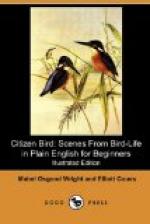“Well, the Snipe that comes about here belongs to the same family, and also pokes in the mud for its food; that is why it likes to live near fresh water like the Woodcock, where the mud is soft, rather than on the sea-shore, where the sand is gritty. It’s a mighty shy bird and doesn’t tell any one what it means to do. I’ve heard them come calling over the beach at night sometimes though, and I suspect they go to the muddy side of the bar to feed, but I’ve never seen them there. They mostly do their coming and going at night—and fly high too, even then.
“Sandpipers don’t bore in the ground for their food, but just pick it up; so they keep along the shore of either fresh or salt water, some kinds choosing one place and some another. The Spotted Sandpiper is another of the little fellows who sometimes nests back in those meadows. He is not a bit shy, but runs about as tame as a Robin, and he isn’t as big as a Robin either. Sometimes they lay their eggs in the meadow and sometimes among the tuft-grass back of the beach. They lay four eggs, very big at one end and peaked at the other, and put them in the nest with the pointed ends together in the middle, to take up less room; and they’re sandy-colored, spotted all over. They hang about here all summer. We call them ‘teeters’ because they always tip up their tails and bob so when they run. They whistle like this, ‘tweet-weet—tweet-weet!’
[Illustration: Wilson’s Snipe.]
“There’s another mite of a Sandpiper that comes around here late every summer, though it nests way up north. It is the very littlest of all, not bigger than a Sparrow, so pretty and innocent-looking that it ought to go with Singing Birds and never be shot for food. I’ve often had them run along in front of me on the beach, piping as sad as if they were telling me how little and helpless they were, and begging me to ask folks not to shoot them.”
Then Olaf pushed up the creek a little further, hoping to be able to land or else reach some Marsh Wrens’ nests from the boat. But one nest was all they could find—a ball of grasses fastened between two cat-tail flags. Olaf cut the stalks carefully and presented it to Dodo, much to her delight. Then he paddled back to the river, where they found Olive waiting with some beautiful pitcher-plants in her hands, while their uncle said that he had in his handkerchief a strange plant, that ate insects. But Dodo thought that he was joking, and as soon as they were in the sharpie she whispered: “Uncle Roy, you must tell me four tables—Olaf knows the birds by sight, but he doesn’t make them sound as distinct as you do in the telling.”
[Illustration: Least Sandpiper.]
“So missy is flattering her old bird man! Well, tell me the names, for I suppose you can remember them.”
“Oh yes—but come to think of it, I don’t think Olaf said what the Wise Men call these birds. One was a bob-tailed Rail—one was a Snipe with far-back eyes and a finger-beak like a Woodcock’s—one was a Spotted Sandpiper that teeters and whistles ’tweet-weet’—and the other was a tiny little Sandpiper with a very sad cry. Now do you know them?”




